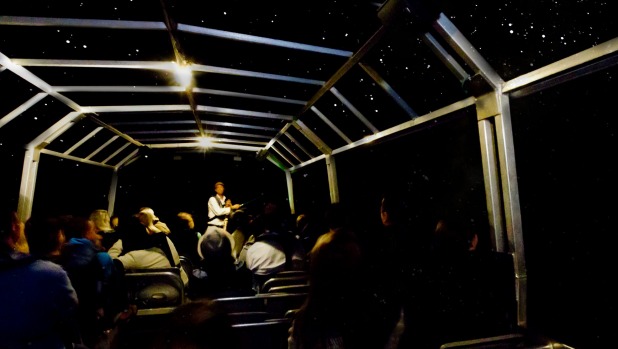
It's nearing 6.45am and the sun is about to rise, though it seems that I may not have risen quite early enough to make it in time for my dawn cruise of Yellow Water in Kakadu National Park. When I finally reach the boat, grateful that either side of the boardwalk along which I'm running is fenced, preventing me from tumbling into the crocodile-infested waters should I slip, I see I am the last to arrive.
It's hard to explain to a boatful of seated, waiting and mostly European tourists with English as a second language that I was up rather late last night. Not carousing, mind you, but cruising these very waters, er, "water". "Sorry everyone," I announce. I receive a chorus of polite, though not particularly sympathetic giggles.
At Yellow Water, the famed billabong in the Northern Territory's even more famous Kakadu National Park, which encompasses nearly 20,000 square kilometres, the options for pleasure cruises are literally as clear as night and day.
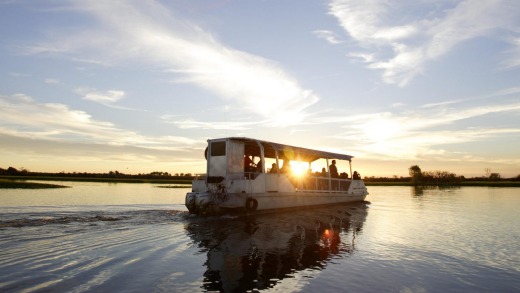
Yellow Water is reputedly so named due to the colour it is meant to resemble when churned up by water buffalo. In addition to the usual daytime excursions, such as this one for early risers, you can these days take a "Yellow Water Under the Stars" night-time tour for a unique perspective on this remarkable sanctuary. Of course, a standard cruise on Yellow Water, part of the extensive, erroneously-named South Alligator River floodplain, is a near mandatory attraction on any Kakadu itinerary.
But by combining a night cruise with its dawn equivalent it's possible to gain even greater insights into this beauteous billabong, teeming with flora and fauna both placid and predatory. Importantly, taking two cruises on extreme ends of the day also renders the Yellow Water a more profound, less touristy experience.
"Ngurrungurrudjba", as Yellow Water is known in the local aboriginal dialect, is located near the remote tourist village of Cooinda, my base for a few nights in Kakadu. Cooinda is less than an hour's drive from Jabiru, the World Heritage Site's charmless main service town.
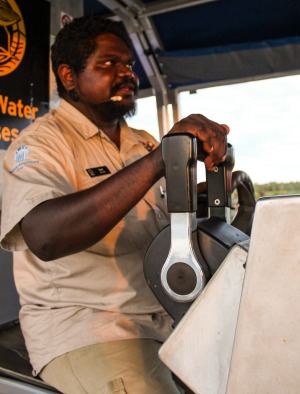
I was right on time, I'll have you know, for my evening Yellow Water cruise, less than 12 hours before, arriving at the jetty in darkness to discover that the canopy of the boat, essential for sun protection during the day, had been removed to afford uninterrupted views of the stars.
Tonight we're guided not just by traditional owners of the park, who are also the proprietors of Yellow Water cruises as well as Cooinda and other Kakadu tourism attractions, but also by the light from the night sky. The after-dark mood is preserved with the captain resorting to battery and boat-generated beams only for occasional navigation purposes and for spotting wildlife, including crocodiles.
Under a typically pristine, star-speckled outback sky, with a half-moon suspended above us, the only other light source (aside from that of my iPhone, which I use to pen notes) is that of an orange kind in the form of the regenerative fires that burn here in the dry season, both controlled and uncontrolled. It's a spectacular, and somewhat haunting, natural light show.
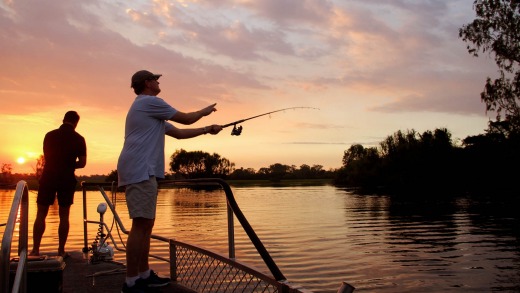
As we glide down the billabong in darkness, with the smoke from the fires a pervasive presence, a spotlight from the boat illuminates a herd of lumbering water buffalo, an introduced species which today provides a source of protein for indigenous owners as well as a lucrative live-meat export industry to Asia, from where the species was introduced. Brumbies, another feral species, also inhabitant the park. Tonight they're not to be seen, though we have sighted them in numbers elsewhere, just outside the park's boundaries.
After dark is an optimum time to view saltwater crocodiles. With their advanced night vision, they like to hunt at night and, if anything, these extraordinary primeval creatures are even more sinister at this hour. As we glide onwards, Mandy, our indigenous guide, pinpoints in one section of Yellow Water no fewer than half a dozen crocs, the tell-tale snouts and eyes of some of them the only visible features.
In contrast to daylight hours, when Yellow Water can be busy with sightseeing boats, tonight we feel as though we have this watery world entirely to ourselves, and, of course, the fearful number of lurking salties and associated loitering birds and mammals.
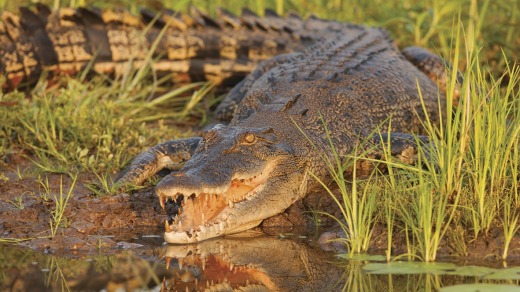
Our attention is not exclusively on the water. Aborigines were among the first astronomers and Mandy employs the rays of her torch to trace the form of an emu in the expansive Milky Way.
Further on, with the tour narration inevitably returning to the subject of our reptilian friends, Mandy explains how her female ancestors would fish for snakes in Yellow Water, being sure to stay in a large group so as to appear as a threat to the crocodiles.
The next morning, after experiencing Yellow Water after dark, the billabong has a lot to live up to, and I'm eager to see it reveal itself in full light.
After having settled into the cruise after my near miss, a layer of mist has curled itself around Yellow Water with the certainty of fairy-floss around a stick. From nowhere another flat-bottomed cruise boat emerges from beneath the fog only to disappear back into it.
Birdlife abounds in Kakadu, the habitat for nearly 300 species of birds. We pass an oblivious white-bellied sea-eagle perched on the edge of dead tree branch, as well as whistling ducks, which, true to their name, whistle rather than quack. In the distance, brolgas, with their long, twig-like legs, prance as only brolgas can prance. It's the nearest you get in these parts to a ballet recital, and an impressive one, too.
In the cold – make that increasingly warm – light of day, I can sense the value of experiencing Yellow Water at those two different times. Yellow Water by day and night are two different worlds. It's quite a commitment in that you're staying up late only to rise before dawn, but the rewards are immense.
As we gently negotiate a bend of the billabong, floating past a garden of water-lilies, their leaves the size of extra-large, upturned sombreros, the mist begins to lift, just as the sun fully rises from above a clump of shaggy paperbarks, drowning the silvery sky in a pink hue. It's still so early that some of the shocking-pink flowers of the water-lilies are yet to open.
Our guide introduces us to "Max", at 4½ metres in length the biggest saltie in Yellow Water. He is infamous for once having devoured an entire fellow crocodile.
The boat draws near to a group of whistling ducks perilously close to the bank as a crocodile approaches.
All of the passengers on the boat, myself included, await a gory cull. However, for some reason, in a rare happy ending involving a saltie here in Kakadu, he spares them. The ducks, with a modicum of the luck I earlier demonstrated in not missing the boat, waddle away unscathed to live another day, and night, here in this magnificent place.
www.travelnt.com
www.kakadutourism.com
Qantas, Virgin Australia and Jetstar all operate regular flights to Darwin from Sydney and Melbourne with their frequency dictated by seasonal demand. See www.qantas.com; www.virginaustralia.com; and www.jetstar.com
Entry to Kakadu is by a $25 per person park pass, valid for 14 days. Daytime cruises at Yellow Water operate year round, while the night-time equivalents run in the peak dry season and recommence in June. The tour departs at 7.45pm and costs $90 per person. Children under eight years of age are not permitted on the evening cruise. The dawn cruise, leaving at 6.45am, costs $99 per person and includes breakfast. Check on the availability of discounts offered if you take more than one cruise on Yellow Water. See www.kakadutourism.com
Kakadu National Park is about three hours driving time from Darwin. The nearest accommodation to Yellow Water is the remote 48-room village-style Cooinda Lodge. The renovated motel-style rooms are comfortable and there's a pool, restaurant and bar as well as a handy petrol station and general store. Rooms start from $139. See www.kakadutourism.com; www.accorhotels.com.au
One of the word's great biodiverse marvels, the 20,000-square kilometres UNESCO World Heritage-listed Kakadu National Park is jointly managed by the Bininj/Mungguy people and Parks Australia. See www.kakadutourism.com; www.travelnt.com; www.parksaustralia.gov.au.
Kakadu's dry season, with its forgiving temperatures and little or no rain, is the most popular time for international and domestic tourists. But the lush "green season" – the tourism industry's euphemism for the "wet" – can be even more rewarding. See www.travelnt.com; www.kakadutourism.com.
Warradjan, developed by Kakadu's traditional owners, is located just a kilometre up the road from Cooinda Lodge. On display are fascinating artefacts that illustrate stories of traditional aboriginal life and culture in the region. See www.kakadutourism.com.
There are no fewer than 5000 rock art sites in Kakadu National Park. One of the most accessible is Nourlangie Rock, where an easy-to-navigate network of paths and stairs lead visitors to remarkable displays of "X-ray art". See www.parksaustralia.gov.au; www.travelnt.com.
Bamurru Plains lies just outside Kakadu National Park. Located on a privately-owned water buffalo station, a stay at this lodge includes guided four-wheel-drive tours and airboat rides on the extensive floodplains. See www.bamurruplains.com.